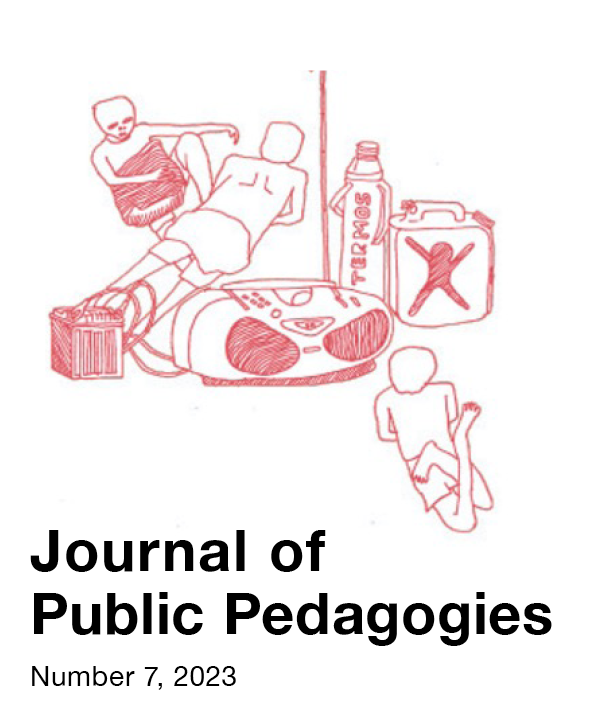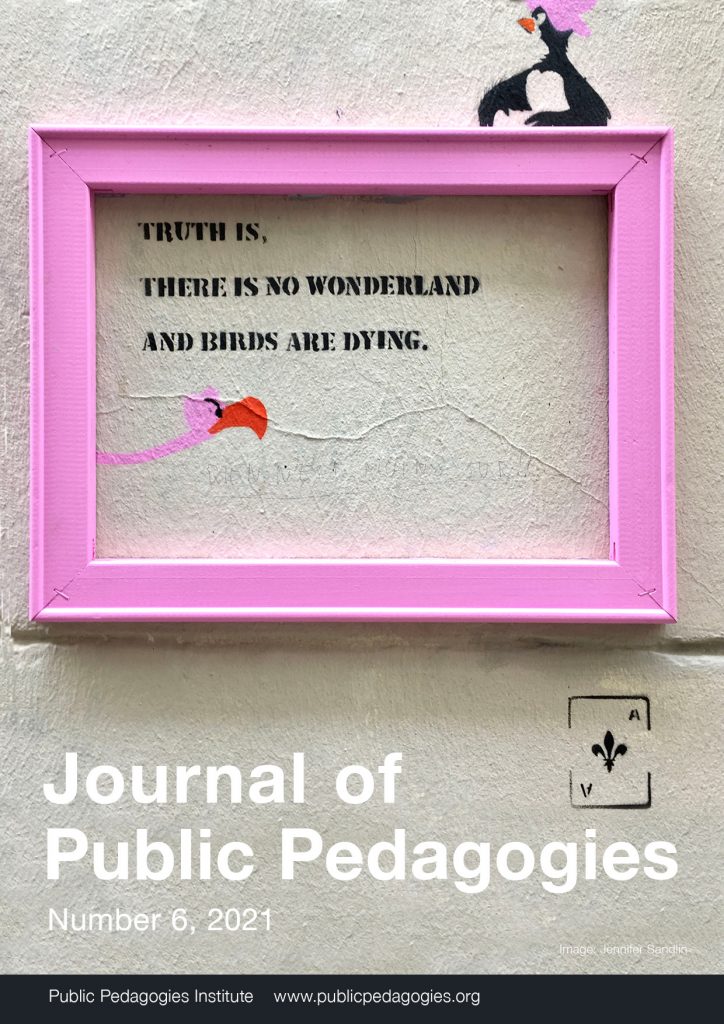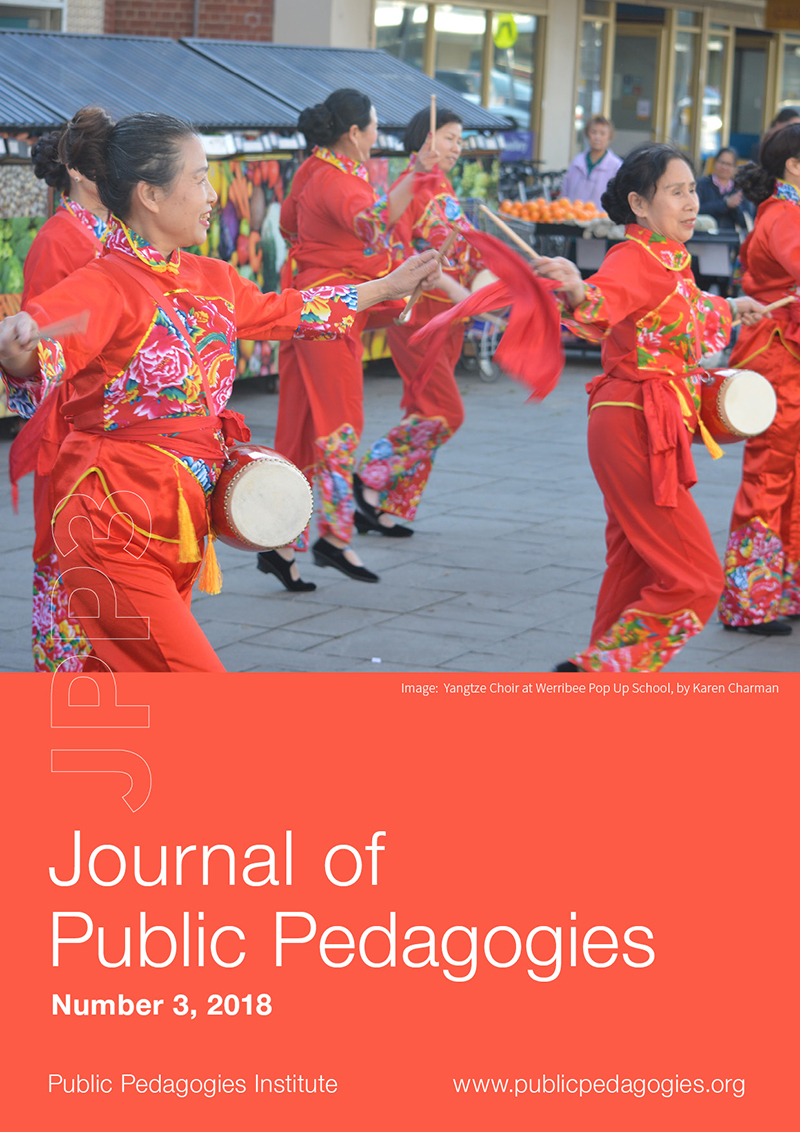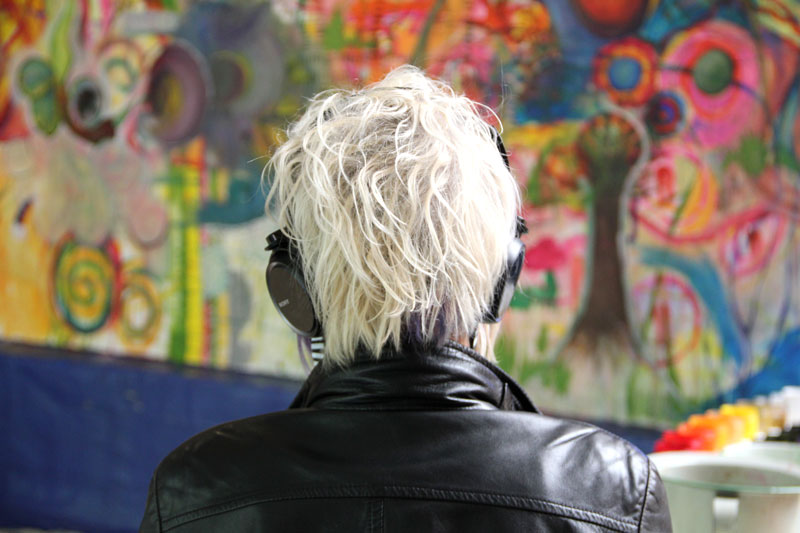Image: Coffee and the Makers: one of the tools at the School of Improper Education, 2019, KUNCI, by Agen OH
(Launching August, 2023)
Journal of Public Pedagogies, Number 7, 2023
ISSN 2207-4422
Forms for Encounter & Exchange: Artist-led approaches to public pedagogy in the Asia Pacific region, a special edition of the Journal of Public Pedagogies
Guest Editors:
Ferdiansyah Thajib, Kelly Hussey-Smith, Gatari Surya Kusuma,
Diwas Raja Kc, and Marnie Badham
Contents:
Sensing Sideways: co-editors’ dialogic introduction to artist-led
approaches to public pedagogy in the Asia Pacific region
A conversation between special edition journal editors Ferdiansyah Thajib, Kelly Hussey-Smith, Gatari Surya Kusuma, Diwas Raja Kc, and Marnie Badham
Disrupting Artistic Terra Nullius: a focus on the processes and
places of repair
Dr Paola Balla
Embodied Futurities: Alecia Neo’s Socially Engaged Art Practice with Caregivers in Singapore
Jill J. Tan
Caring with Computers: a conversation between Computational Mama and Diwas Raja Kc
Computational Mama and Diwas Raja Kc
Composting our practices (and organisations) through artist-led
pedagogy
Jacina Leong
Fugitive Bakery’s Un-recipe-like Recipe Book: Friendship as Pedagogy
Countering the Insatiable Need to put Tangible Proof above Lived
Experience in the Intangibility of Traditional Academia
Anathapindika Dai and Liza Markus
Of the everyday and play in improper education
Khoiril Maqin
Liquid Architecture, West Space and Bus Projects are disorganising
Channon Goodwin, Joel Stern, and Amelia Wallin
The kNOw school: a post-disciplinary adventure in artist-led
public pedagogy
A conversation between members of the Anga Art Collective (Assam, India) and Kelly Hussey-Smith (Naarm/Melbourne, Australia)
these three words; community activation, knowledge sharing and collaboration through letterpress printing
Jan Brueggemeier and Neal Haslem
Rekindling the spirit of resistance in Ludruk folk art
Riksa Afiaty in Conversation with Moelyono
Connecting literary cultures: towards a methodology for ethical encounter and exchange
Dr Melody Ellis, Prof Francesca Rendle-Short, Prof David Carlin, Prof Lily Tope, Dr Michelle Aung Thin
Image Credit: Jennifer Sandlin
(Launching November 12, 2021)
Journal of Public Pedagogies, Number 6, 2021
ISSN 2207-4422
Apocalyptic Pedagogies: Rethinking Publics and Publicness in
the Time of Apocalypse
Guest Editors:
Jake Burdick and Jennifer A. Sandlin
Purdue University and Arizona State
Contents
Editorial
Jake Burdick and Jennifer A Sandlin
Apocalyptic Temporalities and Re-Setting the Future: Using Creative Pedagogies to Explore Everyday Cultures of Grief During Pandemic Times
Deborah Madden, Pat Drake, Sara Clifford
Into the UpsideDown: Conspiracy Pedagogies, Critique, and the Apocalypse of Exposure
Jake Burdick and Jennifer A Sandlin
Re-membering Publicness
Jayson Cooper
In the Midst of Madness: Mental Health Literacy as Null to Explicit Curriculum in Public Spaces
Erin Rondeau-Madrid
Urban Pedagogies of Resistance in Apocalyptic Hong Kong
Kelly Ka-lai Chan, Jaz Hee-jeong Choi, and Daniel Harris
Public Rāhui and Road Blocks in Aotearoa: Navigating Iwi/Hapū Perspectives and Mana Motuhake
Mark Harvey
Liberating Curriculum: A Pedagogy of Publicness that Counters Dominant Culture
Janelle Grant
Apocalyptic Pedagogies: Rethinking Publics and Publicness in the Time of Apocalypse
Belinda MacGill
The Ephemeral Public
Karen Charman and Mary Dixon
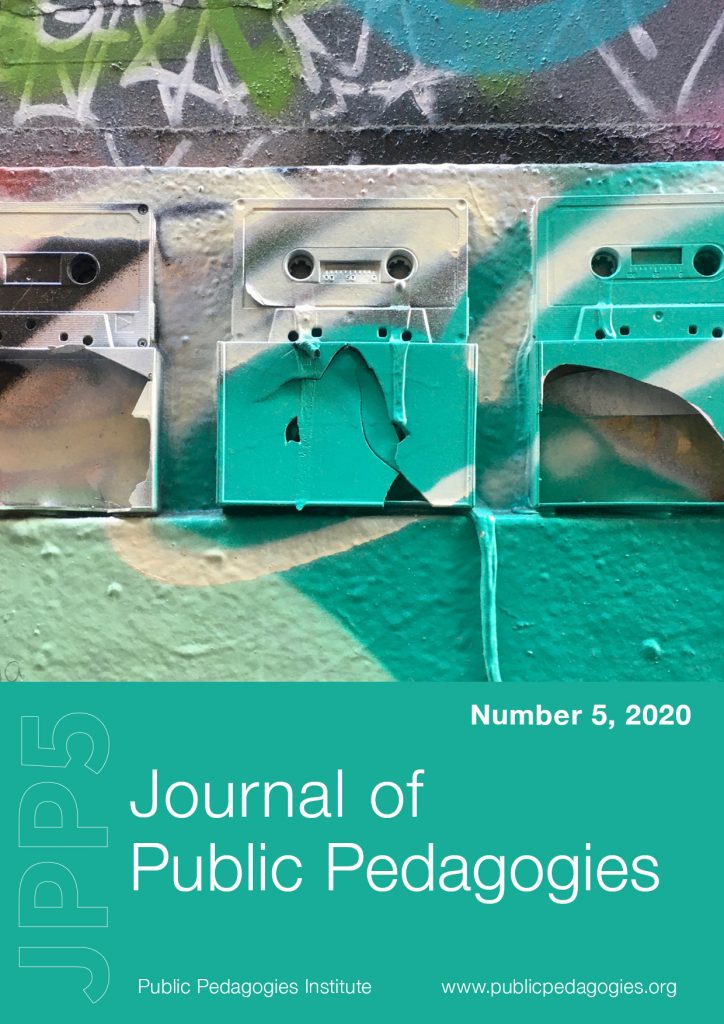
Journal of Public Pedagogies, Number 5, 2020
ISSN 2207-4422
Contents
Editorial
Karen Charman
Walking as a wandering ethic of (re)location:
A public ‘pedagogy of hope’
Genevieve Blades
Hosier and Rutledge Lanes—where anyone can go and make art and other stories
Debbie Qadri
One Step and I am Elsewhere
Greg Giannis
Learning and Experiencing Intra-active Public Pedagogies in Melbourne’s Laneways: Becoming Part of the Palimpses
Jennifer Sandlin and Jayson Cooper
Book Reviews
Karen Charman
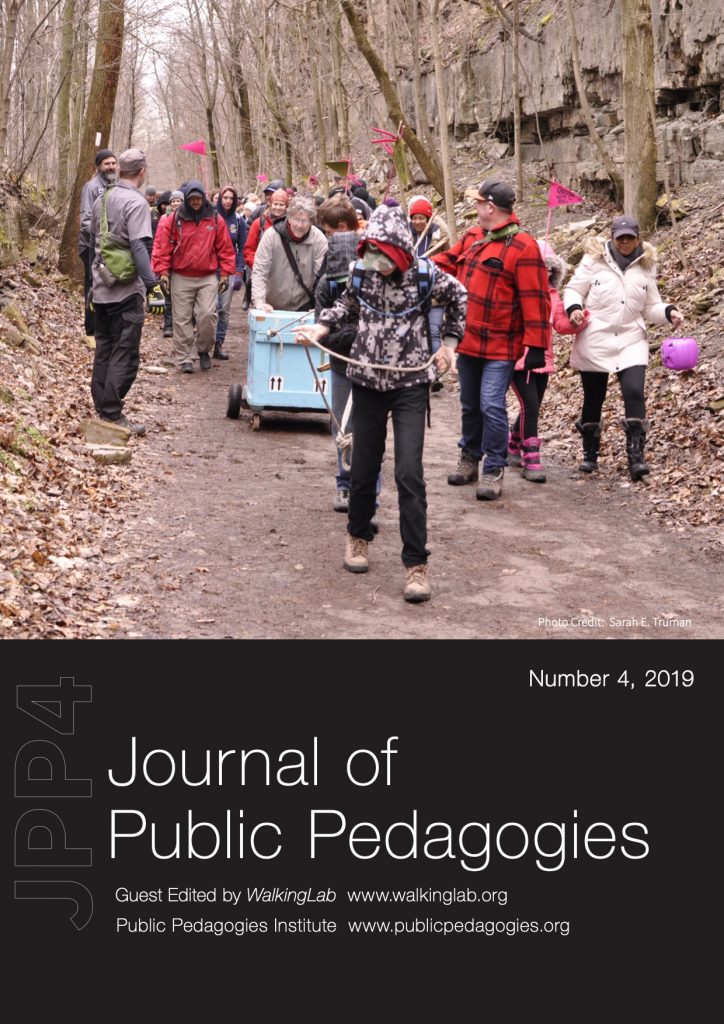
Journal of Public Pedagogies, Number 4, 2019
ISSN 2207-4422
Guest Edited by WalkingLab: www.walkinglab.org
Editorial:
Walking in/as Publics: Editors Introduction
Stephanie Springgay
University of Toronto, Toronto, Canada
Sarah E. Truman
University of Melbourne, Melbourne, Australia
Articles:
Walking Contemporary Indigenous Songlines as
Public Pedagogies of Country
Margaret Somerville
Western Sydney University, Sydney, Australia
Leanne Tobin
Darug artist and singer/songwriter
Jacinta Tobin
Darug language teacher, musician and singer/songwriter
Whitefellas (From the book Walk Back Over)
Jeanine Leane
University of Melbourne, Melbourne, Australia
Walking Borders, Risk and Belonging
Maggie O’Neill
University College Cork, Cork Ireland
Ismail Einashe
Journalist and Cambridge University, Cambridge England
Walking the Places of Exception: The Tule Lake National Monument
Cathlin Goulding
9/11 Memorial & Museum and New York University, New York, The United States of America
Being-in-the-Breathable: An Annotated Walk
Robert Bean and Barbara Lounder
Nova Scotia College of Art and Design, Halifax, Canada
The Pedagogy of Pilgrimage on the Camino de Santiago Written into Performance
Sarah Peters
Flinders University, Adelaide, Australia
Cripistemologies in the City: ‘Walking-Together’ as Sense-Making
Eliza Chandler
Ryerson University, Toronto, Canada
Megan Johnson
York University, Toronto, Canada
Becky Gold
York University, Toronto, Canada
Carla Rice
University of Guelph, Guelph, Canada
Alex Bulmer
Artist in Residence/University of Guelph, Guelph, Canada
‘What could be Feminist about Sound Studies?’: (in)Audibility in Young Children’s Soundwalking
David Ben Shannon
Manchester Metropolitan University, Manchester England
Pedestrian Pedagogy: The Walking Library for Women Walking
Dee Heddon
University of Glasgow, Glasgow, Scotland
Misha Myers
Deakin University, Melbourne, Australia
Queering Pride: Walking Towards a Queer Future in Ireland
Georgina Perryman
Maynooth University, Dublin Ireland
Postcards from the Underground
Astrida Neimanis
University of Sydney, Sydney, Australia
Perdita Phillips
Independent Artist, Perth, Australia
SaltWalks: Vancouver, Nanaimo, Toronto
Randy Lee Cutler
Emily Carr University, Vancouver, Canada
Speculative Harbouring: Wading into Critical Pedagogy and Practices of Care
Susanne Pratt
University of Technology Sydney, Sydney, Australia
Kate Johnston
The University of Sydney, Sydney, Australia
Walking-with Children on Blasted Landscapes
Karen Malone
Swinburne University of Technology, Melbourne, Australia
Mindy Blaise
Edith Cowan University, Perth, Australia
Tonya Rooney
Australian Catholic University, Perth, Australia
Jo Pollitt
Edith Cowan University, Perth, Australia
Walking at Midnight: Women and Danger on Delhi’s Streets
Swati Arora
University of the Western Cape, Cape Town, South Africa
‘Why Do You Need to Know That?’ Slipstream Movements and Mapping ‘Otherwise’ in Tkaronto
Karyn Recollet and Jon Johnson
University of Toronto, Toronto, Canada
Walking as Precarious Public Pedagogy
Kimberly Powell
Pennsylvania State University, State College, United States of America
The School of Site: Istanbul Walkabouts
Nazli Tümerdem
ETH Zurich, Zurich, Switzerland
Walking Brooklyn’s Redline: A Journey through the Geography of Race
Walis Johnson
Artist, Brooklyn, New York, United States of America
Inefficient mapping: the ethical wayfinding potential of drawing while walking
Linda Knight
RMIT University, Melbourne, Australia
Walking Methodologies with/in Teacher Education
Asilia Franklin-Phipps
The Graduate Centre, CUNY, New York
Tristan Gleason
Moravian College, Bethlehem The United States of America
Why Walking the Common is more than a Walk in the Park
Nike Romano
Cape Peninsula University of Technology, Cape Town South Africa
Veronica Mitchell
University of the Western Cape, Cape Town South Africa
Vivienne Bozalek
University of the Western Cape, Cape Town South Africa
A Hijab, A Dog, and Many Histories: Wonders of Intersectional Assemblage in Memphis
Wesam M. Salem, Leslee Bailey-Tarbett, and
Susan Naomi Nordstrom
University of Memphis, Memphis, United States of America
Journal of Public Pedagogies, Number 3, 2018
ISSN 2207-4422
Contents
Editorial
Karen Charman
Running Wild: engaging and empowering future custodians of place through creative nature-based play
Tanja Beer, Andrea Cook and Kate Kantor
The role of pedagogy in peace building: A case from Sri Lanka’s non-formal secondary education sector
Jeremy Cunningham and Suren Ladd
The Threads that Bind Us
Charlotte Clemens and Irene Paulsen
Caroline Chisholm: public pedagogy personified
Flossie Peitsch
Public Pedagogy for the Web: an emergent theory via the
spiral of inquiry
Alison Anderson Holland
Journal of Public Pedagogies, Number 3, 2018
Editorial: Journal of Public Pedagogies
Welcome to the third edition of the Journal of Public Pedagogies.
For the last three years the Public Pedagogies Institute has undertaken research in a defined geographical area in order to understand from the people who live and work there what they consider to be significant knowledge. The premise of this research is the idea that each geographical area has defined knowledge. Despite the shift by Local Governments or City Councils to define larger areas as connected and bounded spaces there persists strong identification with much smaller pockets in the form of suburbs or neighbourhoods. We have named this work the ‘Knowledge Project’.
In last year’s issue of this Journal I contributed to an article that explored this research and the subsequent Pop Up School event in Footscray (Charman, K, et al Journal of Public Pedagogies, No 2. 2017). Since that article we have undertaken projects in Werribee and Point Cook, both in the City of Wyndham, in Melbourne. These projects have confirmed the distinct identity that place carries. This identification might be read as resistance to the imagined homogeneous site of nationalism. As Benedict Anderson (2006 p.6) notes in Imagined Communities when he comments, ‘It is imagined because the members of even the smallest nation will never know most of their fellow-members, meet them, or even hear of them…’.
More significantly the communities of Footscray, Werribee and Point Cook continue to bring into life spaces that push against one national homogeneous imperative and that is to imagine Australia as under threat from those ‘others’ who seek refuge here. Instead in their own distinct ways they look to how to re-settle and grow communities with people who are newly arrived and in this sense people are met, known and listened to. In Werribee and Point Cook, The Wyndham Community and Education Centre continues to be at the forefront of this work and is an exciting site of learning and teaching that is outside of formal educational institutions. This organisation is indicative of the role Community Education Centres and Neighbourhood Houses play in contributing to inclusive communities. This work encapsulates a form of public pedagogy because it provides the broader public with the knowledge that communities are never static but are always evolving in ways that can enrich all of us.
Most of the articles in this edition speak to place in some way. Looking to the future Dr. Tanja Beer, Ms Kate Kantor and Dr Andrea Cook in ‘Running Wild: Engaging and empowering future custodians of place through creative nature-based play’ demonstrate the importance of creative nature-based play to contribute to children’s identity and understanding of the natural world. This is significant because unless successive generations connect with nature in place we are in danger of continuing to disconnect from the environment.
In their article ‘The role of pedagogy in peace building: A case from Sri Lanka’s non-formal secondary education sector’ Dr Jeremy Cunningham and Suren Ladd bring to light the necessity of healing and peace building since the end of the Civil War in 2009. One way this is occurring is through a non-formal curriculum in secondary schools around the themes of truth-seeking, social cohesion and active-citizenship.
Place also functions in our connections to the past. This is something that Charlotte Clemens takes up in ‘The Threads that Bind Us’ when she writes about her connection to the Solomon Islands through her Father, who had been stationed there during the Second World War, and her own subsequent involvement in a UNESCO funded arts project with Dr Irene Paulsen that takes her to the Solomons. The aim of the project is to link students in the Solomon Islands with children here in Australia in order to learn from each other by sharing artworks and stories.
Flossie Peitsch takes us back further in history in her article ‘Caroline Chisholm: public pedagogy personified’. In this article, we can re-visit Chisholm’s creative social intervention that the author reads through contemporary theory on public pedagogy.
Lastly, moving us away from material spaces in both the present and the past, Alison Holland challenges us to think of the web as a site of public pedagogy in her article ‘Public pedagogy for the Web: An emergent theory via the spiral of inquiry.’
In our ongoing dialogue at our yearly conference we continue to collect responses to the question: What is Public Pedagogy? The following sequence of videos speaks to the breadth of understanding of this term and is a great way to finish this editorial.
I hope you enjoy this issue!
Dr. Karen Charman
Videos:
The complete collection of videos from the journal can be viewed here on vimeo
Journal of Public Pedagogies, Number 2, 2017
ISSN 2207-4422
Contents
Editorial
Karen Charman
The Angklung: The Maintenance of Indonesian Cultural Heritage through Public Pedagogy
Yayan Rahayani, Belinda MacGill
The Jewish Holocaust Centre, Melbourne: Public Pedagogies of
Compassion and Connection
John G. Fox
Lawrence-Lightfoot, Rancière and Gemma: Reconciling the
Subject Matter with Research Processes and Outcomes
Debbie Qadri
Crosswalk: Performing the City as a Learning Experience
Raffaele Rufo
Educational Consciousness: Breaking Open the Category of
Knowledge in Footscray
Charman K, Dixon M, Bellingham R, Thomas M & Cooper J
Art & Technology: a Maker Space Experiment for Children
Greg Giannis
Review
Where the Wild Things are: Learning from Tunnerminnerwait and Maulboyheener
Jayson Cooper
Download:
View and Download the entire issue as a single PDF
Editorial, Number 2, 2017
by Karen Charman, Victoria University
Welcome to the second edition of the Journal of Public Pedagogies. At the time of writing this editorial in Melbourne, Australia we are immersed in a public debate on same sex marriage as the Government conducts a postal vote on this ‘issue’. It has been hard to escape the publicness of opinion and the association of the ‘right’ to marry as argued as a threat to heterosexuality and the demise of the nuclear family. Specifically, the idea that being Gay will be become so ‘normalised’ it will be encouragingly taught about in schools. The argument stops just short of the statement ‘they are going to teach you to be gay’. I would argue for strong resistance to public rhetoric designed to further ‘other’ marginalised people such as the LGBTQI community. What this debate has crystalized, among other things, is the necessity and problematics of knowledge constructions outside and inside of formal institutions. As people engaged in the theories and practices of public pedagogies we are called on to think about where knowledges reside and who is determining of what knowledges are valued. Constructions of knowledges are never neutral despite how benign they may appear.
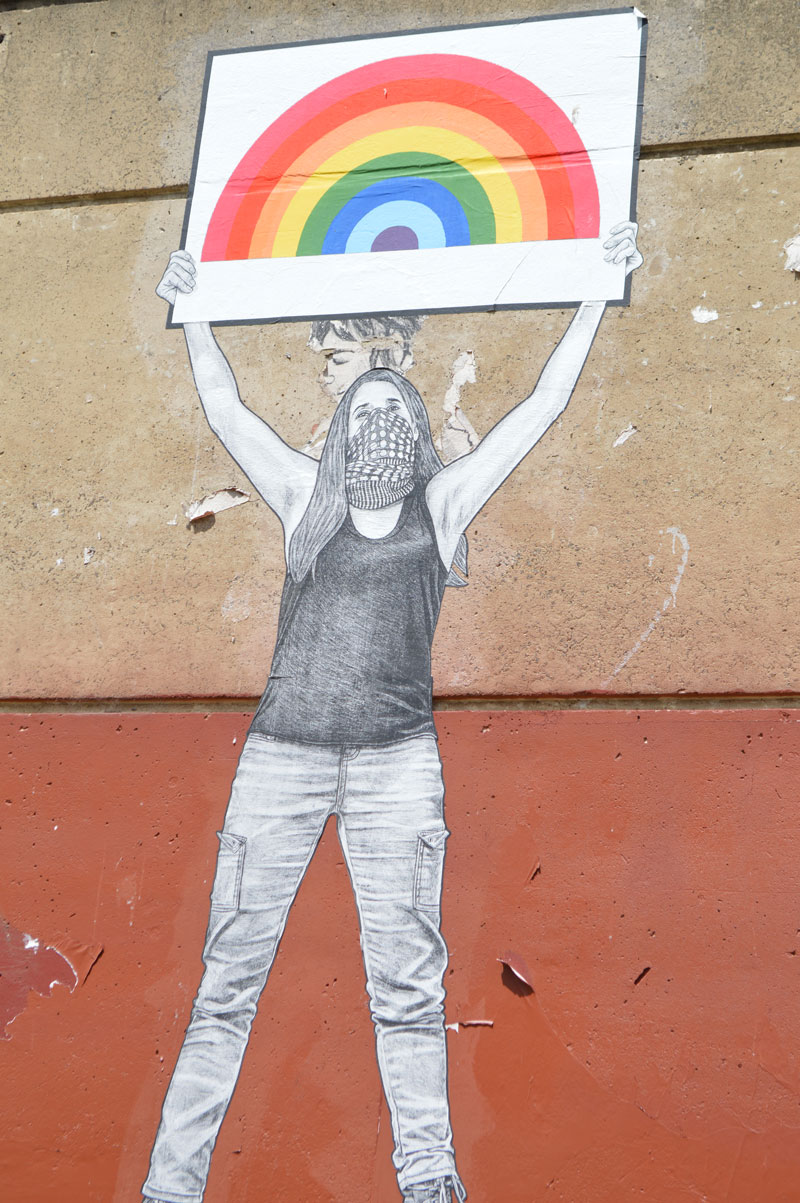
The learning and teaching of knowledge is of deep concern to this Journal and the Public Pedagogies Institute. The intent of the work here and in the Institute, is to shift what knowledge is valued. To this end the articles in this edition contribute to learning and teaching in the broadest possible sense.
We continue to explore understandings of ‘what is public pedagogy?’ through a series of vignettes captured at last year’s conference.
(Link: 2017 JPP Editorial VOXPOP from Victoria University Library)
What is interesting in listening to these discussions are the words ‘connectedness’ and ‘diversity’ associated with Public Pedagogy. These two words do not have to be mutually exclusive and are in fact what might constitute the community of public pedagogues.
The articles in this edition capture the fluidity of what constitutes Public Pedagogies and alert us to urban spaces, cultural institutions, sound and movement, where diverse knowledges are made manifest. In ‘The Angklung: The Maintenance of Indonesian Cultural Heritage through Public Pedagogy’, Yayan Rahayani and Bindi MacGill write about Angklung, noting it is an instrument that is used to retain Indonesian cultural practices and also a metaphor of the hope for social harmony in Indonesia. Significantly it is an instrument that must be played collectively to generate sound. This instrument has been a critical and celebratory part of Indonesian cultural life in South Australia since migration in the 1960s.
John Fox’s article, ‘The Jewish Holocaust Centre, Melbourne: Public Pedagogies of Compassion and Connection’, describes the educational work of the Holocaust Centre. The Jewish Holocaust Centre is a transformative space, as at the heart of this space is the living testimony of survivors. The affect of the museum is essential to our capacity for compassion because, as Fox so eloquently argues, the emphasis on rationality or reason was in part what allowed the Holocaust to occur. Fox draws on the work of Adorno who located the best of our humanity in our bodily reactions. To this end the article makes a persuasive discussion of the power of the museum as enactment of public pedagogy.
In ‘Crosswalk: Performing the City as a Learning Experience’, Raffaele Rufo captures knowledge through sensory experience. His creative immersion in the city occurs through texture, sound, observation and dance. Rufo uses the Argentine tango–a duet dance form structurally based on the improvised relation between dancers and their broader context.
Debbie Qadri’s ‘Lawrence-Lightfoot, Rancière and Gemma: Reconciling the Subject Matter with Research Processes and Outcomes’ is an exploration of the community in research. Drawing on the work of Lawerence-Lightfoot and Jacques Rancière, Quadri looks to broaden and reconcile how community as the object of research can be considered more fully as contributors. This discussion is not just about the research interviews but is also about community art practices. Who is the maker of the art work, the artist or the community contributors?
‘Education Consciousness: Breaking Open the Category of Knowledge in Footscray’ is an article co-authored by myself and colleagues from the Public Pedagogies Institute, which theorises the current major project of the Institute—Pop Up School and Educational Consciousness. This project reflects a critical engagement with what constitutes knowledge. We have undertaken an iteration of this project in Footscray, an inner suburb of Melbourne. However, the entire project is not just the Pop Up School event but also the collection of responses to the question of ‘what is knowledge in Footscray?’. This article explores an understanding of knowledge relative to a geographical space. The authors have tended to think of this knowledge as educational consciousness, as all knowledge that has been learnt is brought to the fore as contributing a consciousness of what we now know.
In what we hope is the first of many articles that focus on the practice of public pedagogy, Greg Giannis describes a vibrant program that is a confluence of community, public space and children in ‘Art & Technology: a Maker Space Experiment for Children’. The self-determining aspect of the children in a space is encouraging as a site for learning beyond the formality of schooling.
Lastly in our review article, ‘Where the Wild Things are: Learning from Tunnerminnerwait and Maulboyheener’, Jayson Cooper reviews a public art installation by local artists Brook Andrew and Trent Walker. This installation commemorates the story of Tunnerminnerwait and Maulboyheener, two indigenous men who were publicly executed. This is a permanent installation (war memorial) to remember this event called, Standing with Tunnerminnerwait and Maulboyhenner.
Acknowledgements
Thank you to the peer reviewers for their work in supporting this edition and to Debbie Qadri for allowing us to use her fantastic art work. I would also like to give a big thank you to Dr. Jayson Cooper, Assistant Editor, and Claire Rafferty, Editorial Assistant, for all of their work.
Video Link:
Public Pedagogies Vox Pop 2016, https://vimeo.com/241816421
Journal of Public Pedagogies, Number 1, 2016
ISSN 2207-4422
Contents
Editorial
Karen Charman
Public Pedagogy at The Geelong Powerhouse: Intercultural Understandings Through Street Art within the Contact Zone
Belinda MacGill
What Does Public Art Teach Us?
Public Art, Public Pedagogy and Community Participation in Making
Debbie Quadri
Pocketing Prayer, Pedagogy, and Purple Hair:
A Story of Place and Belonging, 2010–2015
Flossie Peitsch
The Deep End: Pedagogy, Poetry and the Public Pool
Lucinda McKnight
The Phenomenology of Monologue Writing as Pedagogy
Scott Welsh
Reviews
Advertising and Public Memory: Social, Cultural and Historical Perspectives on Ghost Signs, Stefan Schutt, Sam Roberts and Leanne White (Eds)
Review by Karen Charman
Editorial, Number 1, 2016
by Karen Charman, Victoria University
Welcome to the first edition of the Journal of Public Pedagogies. This journal is a publication of the Public Pedagogies Institute (PPI). The focus of the journal is to publish articles that engage in discussion about learning and teaching outside formal educational institutions. These areas include arts, community engagement, social pedagogy, public history, work in and research on public institutions like museums, libraries, neighborhood houses, community centers, practice, research and evaluation in public pedagogies. The intent of this journal is to actively promote multiple ways of knowing and being in the world speaking within and to the public sphere. This journal celebrates the transformative articulations that express multidisciplinary conceptions of the public while challenging how these ways of being and knowing are pedagogical within the everyday.
The whole notion of what constitutes Public Pedagogies is something the Institute and this Journal sees as evolving. In our call for papers for our 2015 conference we were deeply informed by the work of Mike Burdick, Jennifer A. Sandlin and Michael P. O’Malley (2014) in their edited collection Problematizing Public Pedagogy and The Handbook of Public Pedagogy (2010). We were fortunate, through funding provided by Victoria and Deakin Universities, to have Jennifer Sandlin as one of our keynote speakers. Perhaps because of the neo-liberal and conservative times we find ourselves in or because the best ‘work’ occurs beyond the remit and often constraints of formal sites of learning and teaching the Public Pedagogies Institute has continued to grow. At our 2015 conference we collected responses to the question what is public pedagogy? This exploration takes us into other questions such as what is learning and what is the relationship of learning to the term pedagogy.
In some instances the very irreducibility of public pedagogies is what is engaging about the term.
What effect is neo-liberalism having on the term public? Can thinking educationally through the term public pedagogies create a space or an intervention?
Whose knowledge is valued in more formal institutions? It could be argued that an increasing shift toward vocational education within formal institutions of learning is completely reductive in the generation of other forms of knowledge.
In this inaugural journal issue you will find articles that reflect the breadth of our 2015 conference—Turning Learning Inside Out. Meghan Kelly engages the sometimes false binaries between institutional and community learning in a project undertaken in Kelabit Highlands. In her article ‘Public learning derived from institutional learning: the case study of the Kelabit Highlands Community Museum development’, the focus is on the reciprocal learning that occurs through studies abroad programs. Belinda MacGill in ‘Public Pedagogy: representational shifts in Indigenous political narratives’ looks at the problematics of the representation of indigenous people through contrasting murals painted by indigenous artists at the Geelong Powerhouse, and material culture in the South Australian Museum. She suggests the Geelong Powerhouse potentially offers meaningful micro encounters and within these encounters new notions of citizenship.
Debbie Qadri in ‘Public Art, public pedagogy and community participation in making’, argues for the recognition of community involvement in making public art. Often negated or considered less than other public art, this article attends to the richness and multi-layered experience of community art in public spaces. ‘Pocketing prayer, pedagogy and purple hair: A Story of Place and Belonging 2010 – 2015’ Flossie Peitsch problematizes knowledge bringing to the fore what may not normally be considered of value.
In ‘The deep end: pedagogy, poetry and the public pool’ informed by new materialism Lucinda McKnight explores causality and design in the public space of the swimming pool. Her expression of this pedagogy, perhaps the pedagogy of new materialism, is expressed poetically. In ‘The phenomenology of monologue writing as pedagogy’ Scott Welsh looks at the playwright’s practice of writing as an act of public pedagogy. In this article he looks at the use of monologue to create empathy in teacher education classes.
I hope you enjoy reading these articles, as we are extremely pleased with this first edition. Thank you to the peer reviewers for their work in supporting this first edition! I would also like to give a big thank you to Dr. Jayson Cooper, Assistant Editor and Claire Rafferty Editorial Assistant, for all of their work and for making editorial meetings fun. Lastly, a note of thanks to the College of Education, Victoria University, Melbourne Australia, for their generous grant that enabled us to get this edition up and running.
Dr. Karen Charman
Editor
President, Public Pedagogies Institute
Download
You can download the complete first issue JPP Number 1 as a single PDF here.
About the Journal
The Journal of Public Pedagogies is a peer-reviewed academic journal that is published by the Public Pedagogies Institute. The journal publishes research and practice in learning and teaching that extends beyond the boundaries of traditional or formal educational institutions. These areas may include arts, community engagement, social pedagogy, public history, work in and research on public institutions such as museums, libraries, neighborhood houses, community centers, as well as practice, research and evaluation in public pedagogies.
Editor
Dr Karen Charman, Victoria University
Assistant Editor
Jayson Cooper, Victoria University
Editorial Assistant
Claire Rafferty
International Editorial Advisory Board
Associate Professor Jennifer Sandlin,
Arizona State University, United States
Associate Professor Stephanie Springgay,
University of Toronto, Canada
Associate Professor Anna Hickey-Moody,
University of Sydney, Australia
Professor Maureen Ryan,
Victoria University, Australia
Online Access
This journal is also available online at Victoria University.

